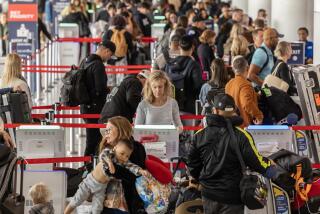Volume at Ports Is on a Record Course
The ports of Los Angeles and Long Beach are poised to set records for container shipping volume this year, benefiting from ever-surging trade with China and, increasingly, new business with India.
Through November, the nation’s largest seaport complex was only a few thousand shipping containers short of the 13.1 million it handled all of last year.
By year-end, officials said, the ports will probably handle more than 14 million TEUs -- or 20-foot equivalent boxes, the maritime industry standard for cargo that is shipped in large containers. That would represent an increase of at least 7%, with total volume exceeding that of the next four busiest U.S. ports combined.
Analysts and shippers remarked on the relative ease with which the two ports have handled the traffic. At this time last year, the complex was only beginning to catch up to a logjam of ships forced to wait as long as a week to unload.
Inaccurate trade forecasts and severe shortage of dockworkers left the ports several dozen crews short of what was needed to load and unload ships. At one point last year, more than 90 vessels were either docked or anchored offshore, awaiting service.
“The operations there have been smoothed out, and Los Angeles and Long Beach are back to being the ports of choice for many shippers,” said Ann Van Praagh, lead analyst for U.S. ports at Moody’s Investors Service in New York.
Officials at both ports cite a variety of factors behind the improved operations. Chief among them were the addition of 6,000 nonunion dockworkers and an extension of gate hours. Now the ports’ terminal gates operate nearly 24 hours a day during the week and are open Saturdays, rather than from 8 a.m. to 5 p.m. and only on weekdays.
The ports also cut the time that containers removed from ships could be allowed to sit idle at terminals to a maximum of five days from as many as 10 or 11. Customers that allow their containers to exceed the time limits are subject to fines.
“This reduces the inventory of containers sitting in the yards. You’re less likely now to have to move containers to get to the boxes you want,” said Don Snyder, director of trade and maritime services for the Port of Long Beach, where traffic is up 19% from last year.
Some of the ports’ most vocal critics have applauded the changes, including Isaac Larian, president and chief executive of MGA Entertainment in Van Nuys, maker of the Bratz line of dolls. “I’m surprised and pleased by what they have accomplished,” he said.
Phillip T. Wright, vice president, West Coast, for Zim-American Israeli Shipping Co. of Long Beach, credited a greater availability of skilled dockworkers to operate the giant cranes and forklifts that unload ships and move containers about the yards.
Trade experts expect the flow of cargo to continue a sharp upward trend, especially now that India has greatly increased its manufacturing and exporting capacity. Although China remains the trade juggernaut on the West and East Coasts, several U.S. ports reported that trade with India was growing faster.
California’s exports to India have risen sharply this year, amounting to $955 million through the first three quarters, almost equaling the $1 billion recorded for all of 2004, according to the Los Angeles County Economic Development Corp.
Projecting that the surge in traffic would continue next year and beyond, port officials say several challenges lie ahead. One of the most important is to determine how to handle more trade while limiting the effects of diesel pollution at the ports from truck and ship traffic.
One way to do that, they say, is to increase the number of containers that can be moved directly onto rail cars at the ports.
“Right now, we can get 15% to 20% of the containers directly onto rail cars, eliminating that much truck traffic from the freeways,” said Long Beach official Snyder. “Moving to 30% to 40% would be the goal, and that would be much more efficient and less polluting.”
More to Read
Start your day right
Sign up for Essential California for news, features and recommendations from the L.A. Times and beyond in your inbox six days a week.
You may occasionally receive promotional content from the Los Angeles Times.







